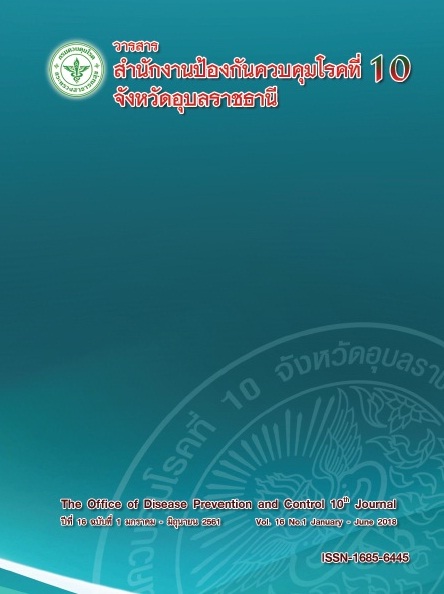การลดระยะเวลาการวินิจฉัยการติดเชื้อ Burkholderia pseudomallei โดยวิธี Latex Agglutination
คำสำคัญ:
เมลิออยโดสิส, Burkholderia pseudomallei, latex agglutination, โรคติดเชื้อ, การตรวจวินิจฉัยบทคัดย่อ
โรคเมลิออยโดสิสเป็นโรคที่เกิดจากการติดเชื้อแบคทีเรีย Burkholderia pseudomallei (Bp) ซึ่งอัตราการรอดชีวิตของผู้ป่วยเหล่านี้สัมพันธ์กับการวินิจฉัยและการรักษาที่ถูกต้องเหมาะสมอย่างทันท่วงที ด้วยข้อจำกัดของการวินิจฉัยการติดเชื้อโดยวิธีการเพาะเลี้ยงและทดสอบระบุชนิดเชื้อด้วยวิธีชีวเคมีซึ่งเป็นวิธีมาตรฐานต้องใช้ระยะเวลาในการรอผลนาน ผู้วิจัยเสนอแนวคิดที่จะนำชุดทดสอบ latex agglutination test มาใช้สำหรับตรวจคัดกรองเชื้อ Bp ควบคู่กับการยืนยันผลการตรวจด้วยการเพาะเลี้ยงและระบุชนิดเชื้อ เพื่อความรวดเร็วในการวินิจฉัย การศึกษาครั้งนี้มีวัตถุประสงค์คือ การประเมินเพื่อยืนยันประสิทธิภาพของ latex agglutination test สำหรับตรวจคัดกรองเชื้อ Bp เปรียบเทียบกับวิธีมาตรฐานคือการทดสอบระบุชนิดเชื้อแบคทีเรียด้วยวิธีทางชีวเคมี โดยการวิเคราะห์ค่าความไว (sensitivity), ความจำเพาะ (specificity), ค่าการทำนายผลบวก (positive- predictive value), ค่าการทำนายผลลบ (negative-predictive value) และค่าความถูกต้อง (accuracy) โดยการศึกษาข้อมูลย้อนหลังในช่วงเดือนตุลาคม พ.ศ.2558 ถึงเดือนสิงหาคม พ.ศ.2560 รวบรวมข้อมูลผลการตรวจวินิจฉัยชนิดเชื้อในสิ่งส่งตรวจของผู้ป่วยในโรงพยาบาลนครพนมที่มีอาการสงสัยการว่ามีการติดเชื้อแบคทีเรียและเก็บสิ่งส่งตรวจเพื่อเพาะเชื้อจากตัวอย่างเลือด, หนอง (pus), เสมหะ (sputum), ปัสสาวะ (urine), และของเหลวจากร่างกาย (body fluid) โดยการนำโคโลนีประเภท Gram-negative non-lactose fermenter ที่ให้ผลบวกต่อการทดสอบ oxidase ทดสอบด้วย latex agglutination test เพื่อรายงานผลตรวจคัดกรองเชื้อ Bp จากนั้นนำโคโลนีดังกล่าวไปทดสอบทางชีวเคมีเพื่อระบุชนิดเชื้อ (biochemical identification) จนกระทั่งให้ได้ผลรายงานสุดท้าย จากข้อมูลผลการตรวจวินิจฉัยชนิดเชื้อจากโคโลนีที่สงสัยจำนวนทั้งสิ้น 637 ตัวอย่าง พบว่าประสิทธิภาพของชุดทดสอบ latex agglutination test ในการวินิจฉัยเชื้อ Bp จากตัวอย่าง hemoculture จำนวน 401 รายให้ค่าความไว 100%, ความจำเพาะ 96.7%, ค่าการทำนายผลลบ 100% ,ค่าการทำนายผลบวก 99.4% และค่าความถูกต้อง (accuracy) 99.5% ส่วนกรณีการใช้งานกับสิ่งส่งตรวจกลุ่มอื่นๆ นอกเหนือจาก hemoculture จำนวน 236 รายนั้น พบว่าประสิทธิภาพการตรวจวินิจฉัยถูกต้อง 100% โดยการใช้งาน latex agglutination test นั้นสามารถรายงานผลการติดเชื้อ Bp ได้เร็วขึ้นอย่างมีนัยสำคัญ จากผลการศึกษานี้แสดงให้เห็นว่าการคัดกรองและรายงานการวินิจฉัยเชื้อ Bp เบื้องต้นด้วยชุดทดสอบ latex agglutination test ในงานบริการประจำนั้นมีประสิทธิภาพและความถูกต้องสูง อีกทั้งยังสามารถรายงานผลได้รวดเร็วขึ้นเมื่อเปรียบเทียบกับการตรวจวินิจฉัยโดยใช้วิธีการเพาะเลี้ยงและระบุชนิดเชื้อก่อโรคด้วยวิธีทางชีวเคมีเพียงอย่างเดียว
เอกสารอ้างอิง
Cheng AC, Currie BJ. 2005. Melioidosis: epidemiology, pathophysiology, and management. Clin Microbiol Rev. Apr;18(2):383-416.
Wiersinga WJ, Virk HS, Torres AG, Currie BJ, Peacock SJ, Dance DAB, et al. 2018. Melioidosis. Nat Rev Dis Primers. Feb 1;4:17107.
Currie BJ, Ward L, Cheng AC. 2010. The epidemiology and clinical spectrum of melioidosis: 540 cases from the 20 year Darwin prospective study. PLoS Negl Trop Dis. Nov 30;4(11):e900.
Limmathurotsakul D, Wongratanacheewin S, Teerawattanasook N, Wongsuvan G, Chaisuksant S, Chetchotisakd P, et al. 2010. Increasing incidence of human melioidosisin Northeast Thailand. Am J Trop Med Hyg. Jun;82(6):1113-7.
Lau SK, Sridhar S, Ho CC, Chow WN, Lee KC, Lam CW, et al. 2015. Laboratory diagnosis of melioidosis: past, present and future. Exp Biol Med (Maywood). Jun;240(6):742-51.
Inglis TJ. 2010. The Treatment of Melioidosis.Pharmaceuticals (Basel). Apr 27;3(5):1296-303.
Wiersinga WJ, Currie BJ, Peacock SJ. 2012. Melioidosis. N Engl J Med. Sep 13;367 (11):1035-44.
Opota O, Croxatto A, Prod'hom G, Greub G. 2015. Blood culture-based diagnosis of bacteraemia: state of the art. Clin Microbiol Infect. Apr;21(4):313-22.
Limmathurotsakul D, Wuthiekanun V, Wongsuvan G, Pangmee S, Amornchai P, Teparrakkul P, et al. 2011. Repeat blood culture positive for B. pseudomallei indicates an increased risk of death from melioidosis. Am J Trop Med Hyg. Jun;84(6):858-61.
Cheng AC, O'Brien M, Freeman K, Lum G, Currie BJ. 2006. Indirect hemagglutination assay in patients with melioidosis in northern Australia. Am J Trop Med Hyg. Feb;74(2):330-4.
Tiyawisutsri R, Peacock SJ, Langa S, Limmathurotsakul D, Cheng AC, Chierakul W, et al. 2005. Antibodies from patients with melioidosis recognize Burkholderia mallei but not Burkholderia thailandensis antigens in the indirect hemagglutination assay. J Clin Microbiol. Sep;43(9):4872-4.
Suttisunhakul V, Chantratita N, Wikraiphat C, Wuthiekanun V, Douglas Z, Day NP, et al. 2015. Evaluation of polysaccharide-based latex agglutination assays for the rapid detection of antibodies to Burkholderia pseudomallei. Am J Trop Med Hyg. Sep;93(3):542-6.
Kaestli M, Richardson LJ, Colman RE, Tuanyok A, Price EP, Bowers JR, et al. 2012. Comparison of TaqMan PCR assays for detection of the melioidosis agent Burkholderia pseudomallei in clinical specimens. J Clin Microbiol. Jun;50(6):2059-62.
Mathai E, Jesudason MV, Anbarasu A. 2003. Indirect immunofluorescent antibody test for the rapid diagnosis of melioidosis. Indian J Med Res. Aug;118: 68-70.
Houghton RL, Reed DE, Hubbard MA, Dillon MJ, Chen H, Currie BJ, et al. 2014. Development of a prototype lateral flow immunoassay (LFI) for the rapid diagnosis of melioidosis. PLoS Negl Trop Dis. Mar;8(3):e2727.
Pumpuang A, Dunachie SJ, Phokrai P, Jenjaroen K, Sintiprungrat K, Boonsilp S, et al. 2017. Comparison of O-polysaccharide and hemolysin co-regulated protein as target antigens for serodiagnosis of melioidosis. PLoS Negl Trop Dis. Mar;11(3):e0005499.
Suttisunhakul V, Wuthiekanun V, Brett PJ, Khusmith S, Day NP, Burtnick MN, et al. 2016. Development of Rapid Enzyme-Linked Immunosorbent Assays for Detection of Antibodies to Burkholderia pseudomallei. J Clin Microbiol. May;54(5):1259-68.
Chuah SC, Gilmore G, Norton RE. 2005. Rapid serological diagnosis of melioidosis: an evaluation of a prototype immunochromatographic test. Pathology. Apr;37(2):169-71.
O'Brien M, Freeman K, Lum G, Cheng AC, Jacups SP, Currie BJ. 2004. Further evaluation of a rapid diagnostic test for melioidosis in an area of endemicity. J Clin Microbiol. May;42(5):2239-40.
Kohler C, Dunachie SJ, Muller E, Kohler A, Jenjaroen K, Teparrukkul P, et al. 2016. Rapid and Sensitive Multiplex Detection of Burkholderia pseudomallei-Specific Antibodies in Melioidosis Patients Based on a Protein Microarray Approach. PLoS Negl Trop Dis. Jul;10(7):e0004847.
Duval BD, Elrod MG, Gee JE, Chantratita N, Tandhavanant S, Limmathurotsakul D, et al. 2014. Evaluation of a latex agglutinationassay for the identification of Burkholderia pseudomallei and Burkholderia mallei. Am J Trop Med Hyg. Jun;90(6):1043-6.
Anuntagool N, Naigowit P, Petkanchanapong V, Aramsri P, Panichakul T, Sirisinha S. 2000. Monoclonal antibody-based rapid identification of Burkholderia pseudomallei in blood culture fluid from patients with community-acquired septicaemia. J Med Microbiol.Dec; 49(12):1075-8.
Simundic AM. 2009. Measures of Diagnostic Accuracy: Basic Definitions. EJIFCC. Jan;19(4):203-11.
Hoffmaster AR, AuCoin D, Baccam P, Baggett HC, Baird R, Bhengsri S, et al. 2013. Melioidosis diagnostic workshop, Emerg Infect Dis. Feb;21(2).
White NJ, Dance DA, Chaowagul W, Wattanagoon Y, Wuthiekanun V, Pitakwatchara N. 1989. Halving of mortality of severe melioidosis by ceftazidime. Lancet. Sep 23;2(8665): 697-701.
Tiangpitayakorn C, Songsivilai S, Piyasangthong N, Dharakul T. 1997. Speed of detection of Burkholderia pseudomallei in blood cultures and its correlation with the clinical outcome. Am J Trop Med Hyg. Jul;57(1):96-9.
ดาวน์โหลด
เผยแพร่แล้ว
รูปแบบการอ้างอิง
ฉบับ
ประเภทบทความ
สัญญาอนุญาต
บทความที่ได้รับการตีพิมพ์เป็นลิขสิทธิ์ของ สำนักงานป้องกันควบคุมโรคที่ 10 จังหวัดอุบลราชธานี
ข้อความที่ปรากฏในบทความแต่ละเรื่องในวารสารวิชาการเล่มนี้เป็นความคิดเห็นส่วนตัวของผู้เขียนแต่ละท่านไม่เกี่ยวข้องกับสำนักงานป้องกันควบคุมโรคที่ 10 จังหวัดอุบลราชธานีและบุคลากรท่านอื่นๆในสำนักงานฯ แต่อย่างใด ความรับผิดชอบองค์ประกอบทั้งหมดของบทความแต่ละเรื่องเป็นของผู้เขียนแต่ละท่าน หากมีความผิดพลาดใดๆ ผู้เขียนแต่ละท่านจะรับผิดชอบบทความของตนเองแต่ผู้เดียว



